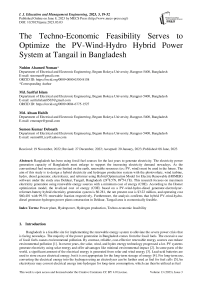The Techno-Economic Feasibility Serves to Optimize the PV-Wind-Hydro Hybrid Power System at Tangail in Bangladesh
Автор: Nuhim Ahamed Noman, Md. Sariful Islam, Md. Ahsan Habib, Sumon Kumar Debnath
Журнал: International Journal of Education and Management Engineering @ijeme
Статья в выпуске: 3 vol.13, 2023 года.
Бесплатный доступ
Bangladesh has been using fossil fuel sources for the last years to generate electricity. The electricity power generation capacity of Bangladesh must enlarge to support the increasing electricity demand nowadays. As the conventional fuel resources are limited on the earth, renewable resources (ex: PV, wind) must be used in the future. The aim of this study is to design a hybrid electricity and hydrogen production system with the photovoltaic, wind turbine, hydro, diesel generator, electrolyzer, and reformer using Hybrid Optimization Model for Electric Renewable (HOMER) software under the study area Delduar, Tangail, Bangladesh (2408.5/N, 89054.1/E). This research focuses on maximum electricity generation using renewable energy sources with a minimum cost of energy (COE). According to the Homer optimization model, the levelized cost of energy (COE) based on a PV-wind-hydro-diesel generator-electrolyzer-reformer-battery hybrid electricity generation system is $0.281, the net present cost is $3.22 million, and operating cost $60,401 with 99.5% renewable fraction respectively. Furthermore, the analysis confirms that hybrid PV-wind-hydro-diesel generator-hydrogen power plant construction in Delduar, Tangail area is economically feasible.
Power plant, Hydropower, Hydrogen production, Techno-economic feasibility
Короткий адрес: https://sciup.org/15018660
IDR: 15018660 | DOI: 10.5815/ijeme.2023.03.03
Текст научной статьи The Techno-Economic Feasibility Serves to Optimize the PV-Wind-Hydro Hybrid Power System at Tangail in Bangladesh
Bangladesh is a feasible site for implementing the renewable energy system to alleviate the severe power crisis that is facing nowadays. The majority of the power generation in Bangladesh comes from the fossil fuels. The excessive use of fossil fuels causes environmental pollution. By contrast, reliable, cost-effective renewable energy sources can reduce environmental pollution [1]. In recent years, the solar, wind, and hydro energy technology progressed a lot. PV systems generate electricity using solar energy and offer advantages like minimal environmental impact [2]. In some parts of the world, a significant amount of the electrical energy is generated from solar and wind energy [3]. Lead-acid batteries are used to store excess electrical energy, but it is not appropriate for the long-term storage of energy [4]. For long-term use, converting the electrical energy into the hydrogen using an electrolyzer can be further used as fuel for fuel cells [5].An electrolyzer may convert electrical energy into hydrogen for long-term consumption, which can then be utilized as fuel for fuel cells. As hydrogen is a clean fuel, hydrogen will be very beneficial for achieving sustainable development of the environment [6]. As opposed to hydrogen manufacturing, solar as well as wind energy can be the good alternative as well. Again, the maximum power point solar tracking control mechanism provides maximum generated power from the photovoltaic system to require the desired magnitude [7]. Due to the dependency on solar [8] and wind energy with respect to climate condition [9], continuous power production is not possible [10]. For getting continuous electricity an alternative traditional fossil fuel (ex: diesel) based power generation system should be used [11]. A hybrid system with photovoltaic, wind, and hydropower increases the efficiency of electric power production[12]. Therefore, hydrogen production offers a viable pathway for the production of the electricity relied on renewable sources and lessens the role of the fossil fuels in the industry. The production of hydrogen reduces the use of fossil fuels in the industry and provides a viable pathway for the generation of power from renewable sources. Many studies have focused on hydrogen production using electrolyzers in hybrid systems to generate electricity in recent years [13]. As electrolyzer has zero emission of harmful gases and uses renewable energy sources to produce hydrogen, that provides better transition for the sustainable environment [14].
Several researchers have researched [15] by various methods[16], especially decision-making process[17], simulation[18], and so on[19]. Following to the simulation procedure, Lau et al. [20] proposed a way to meet the demand for rural areas for electricity power using conventional means such as a diesel generator. Shrestha et al. [21] represented the rising fossil fuel prices substantially impact rural people, and conventional energy generation accounts for CO 2 emissions. Al-Falahi et al. [22] showed that the non-polluting and lifetime supply of PV and wind energy sources were a good contender for conventional energy sources. Laoun et al. [23] indicated the solar PV system for the hydrogen production as well as investigated the impact of each component of overall process. Yilmaz et al. [24] represented the four methods (photo-biological generation, photo-electrolysis, solar power, concentrated solar thermal energy) of the hydrogen production by using the solar energy. Mojtaba et al. [25] showed the techno-economic feasibility of producing electricity and hydrogen in a hybrid power (photovoltaic-wind) system in Hendijan, Iran. Charvez-Ramirez et al. [26] represented the hybrid system of PV-wind-fuel cells to generate electrical energy and hydrogen for conversation into electricity by fuel cells at the University of Zacatecas, Mexico. The study of Joshi et al. [27] evaluated different system of photovoltaic-based hydrogen production methods in which solar thermal concentrating collectors had higher efficiency than photovoltaic systems. Yang et al. [28] represented a thermal, electricity generation hybrid system that consists of PV driven alkaline water electrolyzer for generating hydrogen, which was used to improve the efficiency of hydrogen production.
Research on a hybrid electricity production system by M. A. Habib [29] proposed a hybrid electricity power plant for Rangpur, Bangladesh, in which the cost of energy (COE) is $0.348 per kWh. But in Tangail, Bangladesh, there is no such a hybrid generation system. So, a hybrid electricity system is proposed for the first time almost.
The main aim of the study is to develop a sustainable hybrid power generation system and hydrogen production system with PV, wind turbine, battery, diesel generators, hydropower, electrolyzer, reformer, and hydrogen tank. The designed system focuses on maximum electricity production to use renewable sources with a minimum cost of energy. Homer software optimizes the hybrid system for a primary load demand that minimizes the cost of energy (COE) and the net present cost (NPC), increases the renewable energy fraction (RF), and reduces the emission of harmful gases. For the study area, an optimized hybrid system design is suggested for Delduar, Tangail, Bangladesh, which is one of the most remote areas of Bangladesh. This proposed hybrid system design can also be applied to other remote areas of Bangladesh.
The remaining paper proceeds as follows: Section 2 shows the geographic characteristics of the study area; Section 3 is methodology that introduces the simulation setup; Section 4 explains the techno-economic feasibility analysis of hybrid optimization, and the last one is the conclusions.
2. Methodology 2.1 Geographic characteristics
The study area named Delduar is located in Tangail district in Bangladesh on the bank of the Dhaleshwari river at 2408.5/N latitude and 89054.1/E longitude, which is displayed in the Fig. 1. In Fig. 1, the combination of the green and the red regions shows the whole boundary of Bangladesh [30], only the red color area indicates the location of Tangail, and the blue color demonstrates the inside (outside) river of Bangladesh.
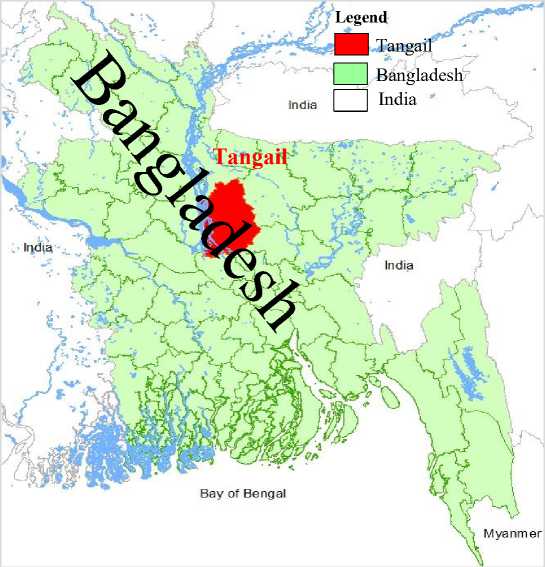
Fig. 1. Map of Delduar, Tangail, Bangladesh
2.2 Simulation setup
3. Techno-economic Analysis3.1 Analysis of wind energy
The study area's potential for wind energy is achieved in the form of generated electricity. The proposed hybrid system wind turbine outputs by using Homer software show the technical-economic feasibility of the hybrid system. Fig. 3 shows the average monthly wind speed data for the research area for different months. The data for wind resources have been taken from NASA's prediction of the worldwide energy resource database from the year of 1984 to 2013 [31]. According to the wind resources, few advanced parameters are presumed; the weibull value (k) is set around 2, which measures the wind speed distribution, the autocorrelation factor that quantifies the randomness of the wind is set to be 0.85, the diurnal pattern strength is set to be 0.25 which implies how the wind speed differs with time in a day, and hour of peak wind speed is set to be 15. According to, Fig. 3 and Table-1, the average wind speed is higher in July, alleviating the shortage of PV power production and having a lower clearness index. According to Fig.3, the maximum and the minimum wind speeds are calculated to be 5.730 m/s in July and 3.160 m/s in November, respectively.
The Homer software is an electricity energy modeling program for HRES. Homer software is a capable tool for designing, simulating that analyzes hybrid power systems. The program flowchart of Homer software for Delduar, Tangail, Bangladesh is shown in Fig. 2.
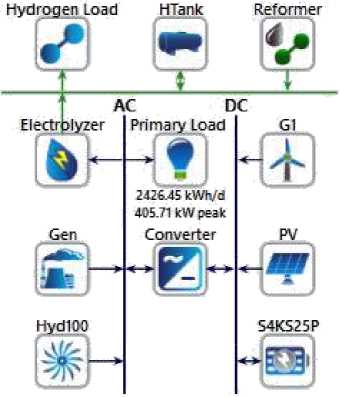
Fig. 2. Homer software simulation setup for Delduar, Tangail, Bangladesh
The Homer software is utilized for the technical economic feasibility of the solar-wind-hydro-hydrogen hybrid system. Solar radiation data and wind speed data for the Delduar, Tangail area are taken from the monthly NASA prediction of worldwide database and imported to the Homer software. Homer software website has been used to import input data of the hydrogen production system. Simulation processes have been carried out on data by 671,248 simulations. In simulation, the equipment used for the solar-wind-hydro-hydrogen hybrid system is a 1kW Generic turbine, an Autosize Genset diesel generator, a 100kW hydro system, a 1 kW PV system, a 1 kW converter, a 1 kg hydrogen tank, and a 1 kW reformer for 25 years.
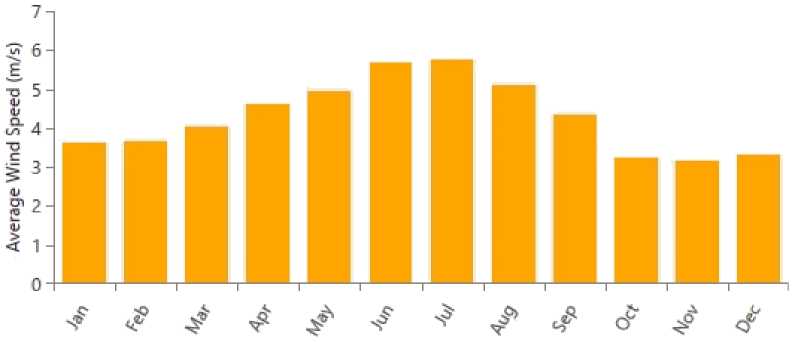
Fig. 3. Wind speed data of different months
The choice of an appropriate turbine is one of a wind power system's most visible components in constructing a wind system because of wind turbines' performance. This study's aim is the possibility or feasibility of hybrid power plants. A Generic 1kW wind turbine is considered a more appropriate turbine in this study. Fig. 4 shows the power output of the Generic turbine at 24 hours of the day and for the all months. From Fig. 4, the turbine has a maximum output depicted by the red color. The call bar of Fig. 4 is for better explanation and realizing of the data map (D-map).
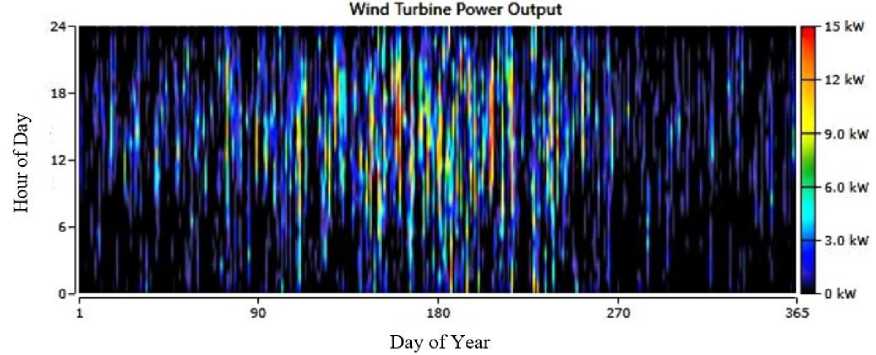
Fig. 4. Wind turbine output at all months per hour of the day in the study area
-
3.2 Analysis of solar energy
The area’s coordinates (longitude and latitude) are imported to the Homer program to verify the feasibility study of the solar energy potentiality in the Delduar, Tangail, Bangladesh area for the proposed hybrid power system. Monthly solar radiation data have been taken from the National Aeronautics and Space Administration (NASA) database from the year of 1983 to 2005 [32]. Table 1 shows the monthly average daily radiation, in which April represents the maximum solar radiation, and Fig. 5 indicates the clearness index, which is low for July and August. The annual calculated daily solar radiation is 4.75 kWh/m2 /'day , and the yearly average clearness index is 0.533. In Fig.6, the
black color indicates the zero output of PV, and the changing color from black to yellow refers to the different magnitude of PV output. Fig. 6 demonstrates the photovoltaic system's output power in which the PV system's output range is between 1.96 kW to 161 kW for 12 hours per day based on each month.
Table 1. Monthly PV-wind resource variation
|
Month |
PV resource |
Wind resource |
|
|
Clearness index |
Daily radiation (KWhm -2 /Day) |
Average wind speed (ms -1 ) |
|
|
January |
0.633 |
4.340 |
3.630 |
|
February |
0.638 |
5.070 |
3.660 |
|
March |
0.630 |
5.870 |
4.040 |
|
April |
0.580 |
6.050 |
4.610 |
|
May |
0.500 |
5.510 |
4.950 |
|
June |
0.423 |
4.740 |
5.650 |
|
July |
0.385 |
4.260 |
5.730 |
|
August |
0.405 |
4.300 |
5.110 |
|
September |
0.405 |
3.910 |
4.330 |
|
October |
0.524 |
4.360 |
3.240 |
|
November |
0.620 |
4.390 |
3.160 |
|
December |
0.642 |
4.170 |
3.300 |
7-i Я Radiation р 1

/ Ч? ? ^ / / ^ / ^ С? / <^
Fig. 5. Solar daily radiation and clearness index of the research area
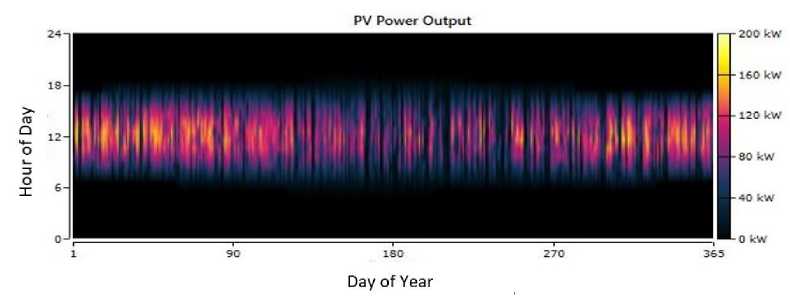
Fig. 6. PV power output of different months per hour of the day
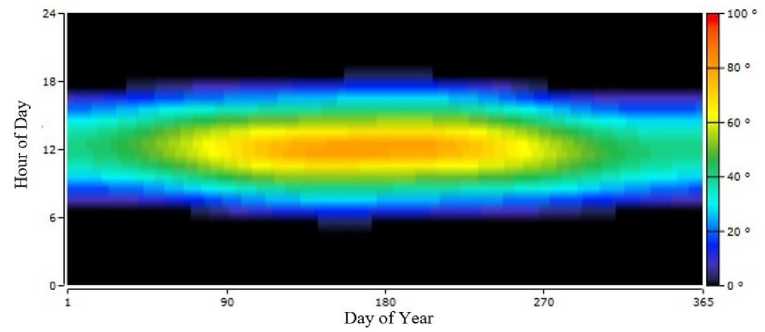
Fig. 7. The altitude of PV array of all months 24 hour of the day
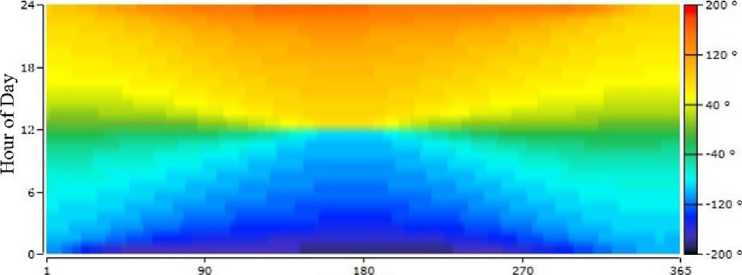
Day of Year
Fig. 8. The azimuth of PV array of all months per hour of the day
The placement method of the PV system is an essential technical factor that should note after checking the potentiality of solar energy for the research area. So, the efficiency of the photovoltaic system mainly depends on the positioning of PV panels in the proper place to absorb sunlight. Fig. 7 shows the altitude of PV panel positioning in the research area in degrees. Fig. 8 demonstrates the azimuth of a PV panel for different hours of the day in all months of the year. In Fig. 8, the azimuth angle is between -200o to +200o. The negative and positive azimuth refers to before and after solar noon.
-
3.3 Analysis of hydrogen potential
The study of hydrogen production system provides technical-economic feasibility and evaluates a hybrid electricity generation system with solar, wind, and hydro. An electrolyzer produces hydrogen through water electrolysis by electricity. A reformer produces hydrogen by reforming hydrocarbon. The reformer in this project uses diesel to produce hydrogen. Monthly average hydrogen production from the reformer is shown in Fig. 9, in which the highest average monthly hydrogen output is 1.6 kg in August, and the lowest output is 0.97 kg in January. The production of hydrogen from the reformer relies on different hours of a day based on different months in the year, illustrated in Fig. 10, in which the highest hydrogen production from the reformer is 2.39 kg per hour for a few months and on particular days. Fig. 11 shows the hydrogen load for the feasible hybrid electricity system. The data’s shown in Fig. 11 have been loaded from Homer's site [33]. Homer software simulates and analyzes during various times of the day and for various months by importing standard data accessable on the Homer site through internet. According to Fig. 11, the highest loaded hydrogen equals 2.39 kg per hour.
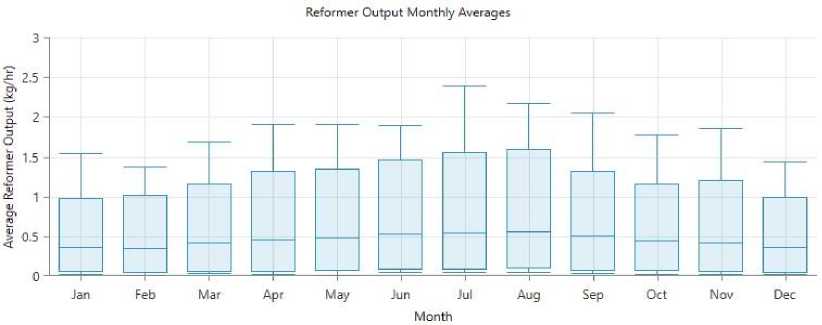
Fig. 9. Reformer monthly hydrogen output
Fig. 12 demonstrates the study area's average monthly hydrogen load for different months. According to Fig. 12, the highest average monthly load of hydrogen is 1.6 kg in August, and the lowest is 0.98 kg in January. Fig. 13 shows the average monthly hydrogen production, and Table 2 shows the yearly hydrogen production from the reformer and electrolyzer. According to Fig. 13, The highest amount of hydrogen is produced in August with 13 kg/day, and January has the least amount of all months, with 8.9 kg of hydrogen production per day. The hydrogen produced is for future use that is stored in the hydrogen tank.
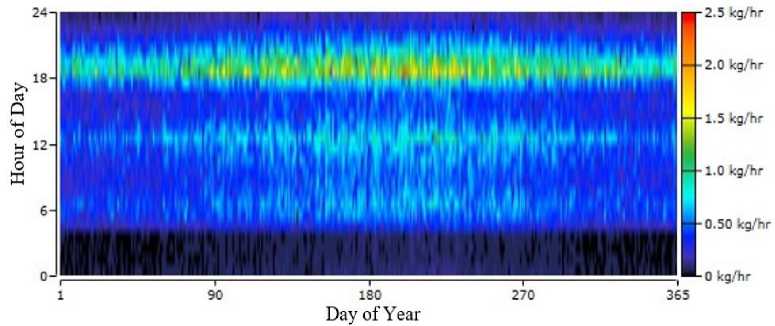
Fig. 10. Hydrogen output of Reformer for different months per hour of the day.

Fig. 11. Hydrogen load per hours per day of any month
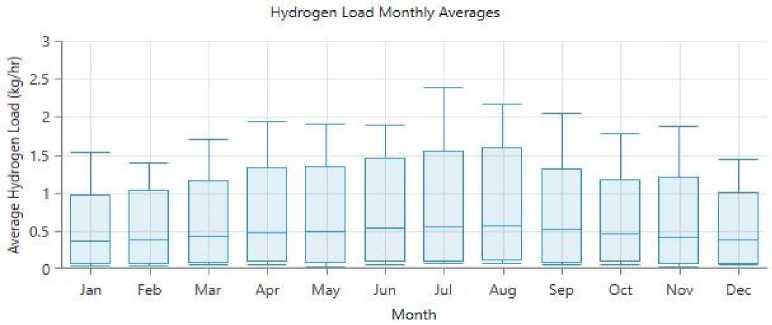
Fig. 12. Hydrogen load monthly average data
Monthly Average Hydrogen Production

Reformer
■ Electrolyzer
Fig. 13. Monthly average hydrogen production.
Table 2. Yearly hydrogen production and consumption
|
Type |
Quantity |
% |
|
|
Hydrogen Production |
Electrolyzer |
112 kg/year |
2.72% |
|
Reformer |
4001 kg/year |
97.3% |
|
|
Hydrogen Consumption |
Hydrogen load |
4,113 kg/year |
100% |
|
Excess hydrogen |
0 kg/year |
0% |
-
3.4 Estimation of electrical load
The overall main load that the system must meet is referred to as the electric load [34]. According to Fig. 14, the average primary load of the study area, Delduar, Tangail, Bangladesh, is 2426.45 kWh/day, 405.71 kW peak, and a load factor of 0.25. The peak month is July. In the proposed system, the PV, hydro, wind, and diesel generator sources serve the electrical load shown in Fig. 15.
-
3.5 Analysis of diesel generator potential
Going through this hybrid power generation system, the diesel generator is utilized to serve the AC primary load. The diesel price is presumed as 0.92$/L. Homer's Autosize Genset diesel generator is set up with 25% minimum load ratio for diesel engines. In Fig. 16, the black color denotes the zero output of the diesel generator, and the changing color from black to red refers to the different values of diesel generator output. According to Fig. 16, the generator is mostly shut off or operating at maximum capacity. When the desired demand level of electricity is not met up by the renewable resources, at the time diesel generator is used as the backup source. When the wind speed, sun radiation, and water stream flow are all low, then the diesel generator is switched on. From Fig. 16, the highest level of electricity output will be 112 kW. Table 3 shows the outcome production data of generated electricity; total electrical production is 4050 kW/year, mean electrical output is 112 kW, and fuel consumption is 1240 L.

Day of Year
Fig. 14. Yearly primary load per day per hour.

Fig.15. Electricity generation sources serve the electrical load.
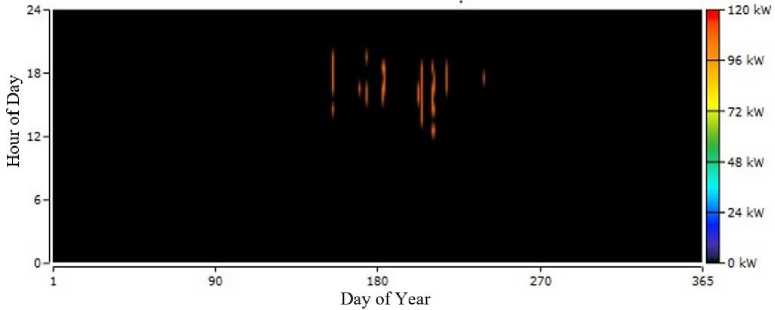
Fig. 16. Generator output power for everyday and every hour
Table 3. Generator production data of electricity
|
Quantity |
Value |
|
Electrical Production |
4050 kW/yr |
|
Mean Electrical Output |
112 kW |
|
Minimum Electrical Output |
112 kW |
|
Maximum Electrical Output |
112 kW |
|
Fuel Consumption |
1,240 L |
|
Specific Fuel Consumption |
0.306 L/kWh |
|
Fuel Energy Input |
12,201 kWh/yr |
|
Mean Electrical Efficiency |
33.2 % |
-
3.6 Analysis of hydro power potential
Hydropower generation utilizes the energy of falling water to generate electricity. The representation of this hybrid project is proposed according to the study area location Delduar, Tangail, near the bank of the Dhaleshwari river. The calculation of the average monthlystream flow of the Dhaleshwari river is shown in Fig. 17. The water discharge data for the Dhaleshwari river are obtained from the Bangladesh Water Development Board (BWDB), Tangail [35]. The average water discharge data have been taken from 2017 to 2020. The stream flow data is measured by the Acoustic Doppler Current Profiler (ADCP) meter, a hydro acoustic current meter. According to Fig. 17, the maximum average discharge of stream flow is in July, which is 701333 L/s, and the lowest average is in February, which is 4449.675 L/s. The hydro power output data is shown in Fig. 18. The Generic hydro 100kW has a nominal capacity of 98.1 kW. The annual production is 1,095,679 kWh/yr.
-
3.7 Storage battery
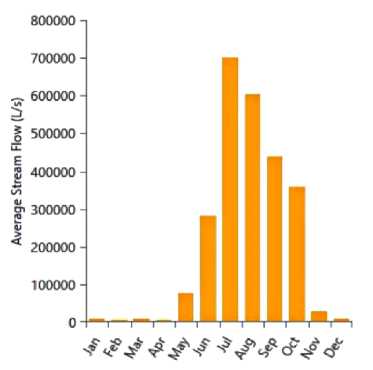
Fig. 17. Average discharge calculation of the Dhaleshwari river
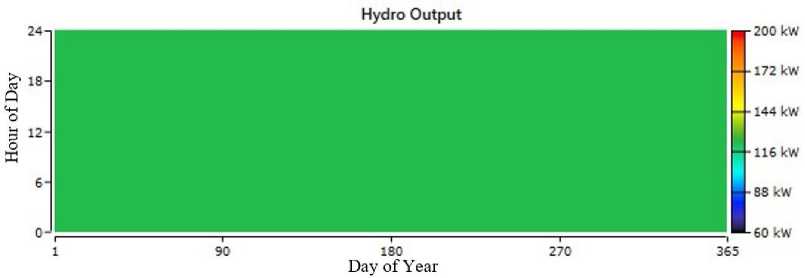
Fig. 18. Hydropower output.
Due to fluctuation and the insufficient certainty of supply of renewable sources, batteries are required to fulfill the demand of electricity. In this study, Surrette 4 KS 25P [36] is the battery selected for energy storage which has a nominal voltage rated at 4 V with a capacity of 7.55 kWh. Fig. 19 depicts the battery's state of charge. In Fig. 19, the red color represents the maximum state of charge of battery, which is 100% in February and the blue color represents the almost minimum state of charge of battery which is 41.05% in September.
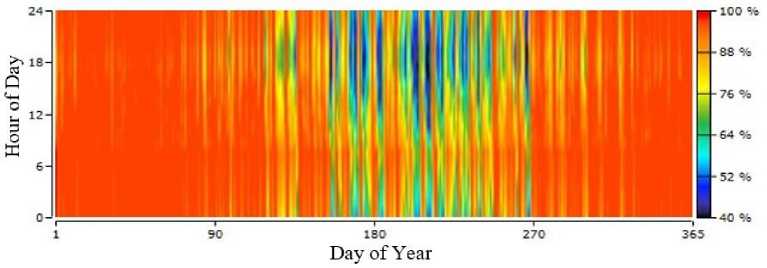
Fig. 19. State of charge of battery
-
3.8 Analysis of converter
-
3.9 System analysis for suggested hybrid power plant
The hybrid system must have a converter to maintain the energy flow between the AC and DC buses [37]. A converter can act as an inverter or as a rectifier. In this study, the converter efficiency as an inverter is set at 90%, and as a rectifier is set at 85%. The converter size is taken by using Homer's auto-size system. The Homer program has been used to simulate the inverter's average monthly input and output power for various months and is represented in Fig. 20 and Fig. 21, respectively. According to Fig. 20 inverter's annual maximum power input is in July, which is 311.82 kW, and the yearly minimum power input is in January, which is 137.91 kW. From Fig. 21 inverter's annual maximum power output is in July, which is 280.63 kW, and the yearly minimum power output is in January, which is 124.12 kW.
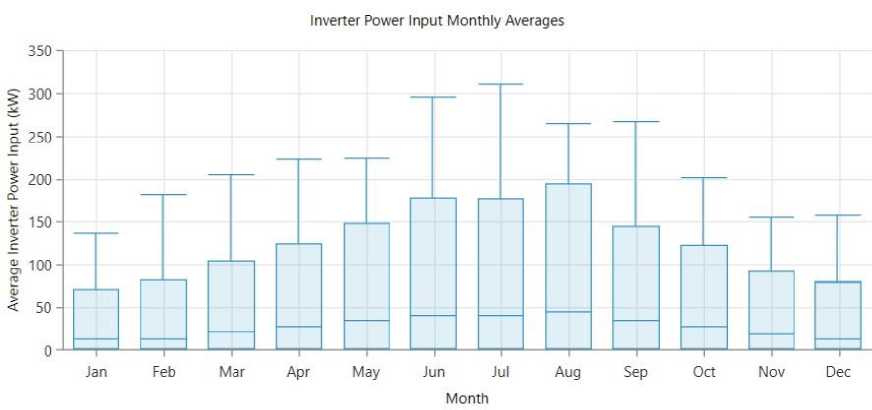
Fig. 20. Inverter power input monthly averages.
For evaluating the performance of different systems, all input data are supplied to the Homer software that simulates and generates the various optimization solutions with different hybrid setups. Homer software has a robust interface and accurate analyzing capabilities for the hybrid energy system. The Homer software simulation has been done for this project's lifetime of 25 years. Fig. 22 shows the optimization results from the Homer software as Homer's key target is to get the hybrid electricity generation model with the minimum cost of energy. The results in Fig. 22 show the optimized net present cost (NPC) and the cost of energy (COE). Among the all optimized hybrid configuration options, the lowest cost of energy for the proposed hybrid system; is PV(162kW), wind turbine (6 kW), hydro (98.1 kW), diesel generator (450 kW), electrolyzer (1 kW), reformer (3 kW) and battery (365), is $0.281 with 99.5% renewable fraction that has a tremendous environmental contribution and the net present cost is $3.22 million as well. For the proposed hybrid system model, the average electricity production is shown in Table 4. According to Table 4, hydropower generates the most significant amount of electricity, whereas other hybrid system components, including wind turbines, photovoltaics, and diesel generators, are less effective. The average monthly electricity production of the proposed hybrid system is represented in Fig. 23. The highest electricity from PV, wind, hydro, and diesel generators is produced in March and the lowest in September. This hybrid system also has some excess electricity shown in Fig. 24. According to Fig. 24, the maximum monthly surplus energy is 134.89 kW in January, and the minimum monthly surplus energy is 43.28 kW in August. This excess electricity can be stored in the battery or used to generate more hydrogen. The electrical energy produced from renewable sources decreases the emission of CO2, SO2, and Nitrogen oxide. The emissions of different gases are shown in Table-5 from the PV-wind-diesel-hydro-electrolyzer-reformer hybrid option, in which the highest emission of Carbon Dioxide is 3,246 kg/year. Thus, hybrid PV-wind-diesel-hydro-electrolyzer-reformer power plant construction in Delduar, Tangail is economically suited, and the project proposal is technically viable. So, the hybrid power plant development in the research area will be a great scope for renewable technology.
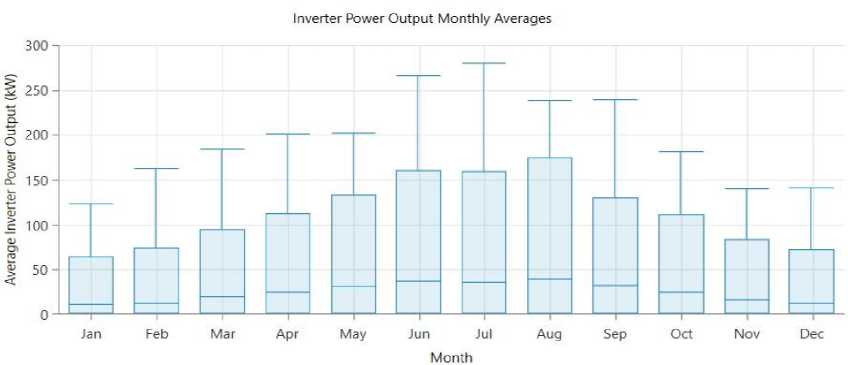
Fig. 21. Inverter power output monthly averages
Architecture Cost
|
■ + |
I 0 * В 6 |
У |
4* |
™ V (kW) 4 |
61 V |
бел „
|
S4KS25PY |
HydlOO v (kW) 4 |
Electrolyzer „ (kW) V |
Reformer „ (kW) 4 |
HTank ст (kQ) 4 |
Convener „ (kW) 4 |
Dispatch V |
-•V |
COl- „ № |
Operating cost * „ (S/vr) V 4 |
Initial capital ст 111 V |
|
V |
ff и № В |
у |
151 |
450 |
399 |
98.1 |
3.00 |
290 |
If |
13,11M |
30271 |
$62,297 |
1230M |
||||
|
V |
f и * В 6 |
У |
151 |
450 |
399 |
98.1 |
1.00 |
3.00 |
290 |
LF |
13,13M |
30273 |
$62,327 |
5232M |
|||
|
С и s В |
у |
W |
151 |
450 |
399 |
98.1 |
3.00 |
1.00 |
290 |
If |
13.13M |
30.273 |
$62,307 |
3233M |
|||
|
V |
1 в» * В В |
V |
V» |
151 |
450 |
399 |
98.1 |
1.00 |
3.00 |
1.00 |
290 |
LF |
13.15M |
30275 |
$61,855 |
32.35M |
|
|
■ + |
S' га # В |
у |
162 |
450 |
365 |
98.1 |
340 |
LF |
13.18M |
30278 |
$60,869 |
S239M |
|||||
|
• 4. |
• е» * В 6 |
у |
162 |
6 |
450 |
365 |
98.1 |
1.00 |
3.00 |
340 |
LF |
13.2OM |
30.280 |
$60,899 |
3241M |
||
|
* 4 |
Г п * В |
У |
*• |
162 |
6 |
450 |
365 |
98.1 |
3.00 |
1.00 |
340 |
LF |
1321M |
30280 |
$60,879 |
3242M |
|
|
V + |
S еэ * В В |
У |
■■ |
162 |
450 |
365 |
98.1 |
1.00 |
3,00 |
1.00 |
340 |
LF |
1322M |
30281 |
$60,401 |
3244M |
|
|
"" 4* |
и * В |
V |
137 |
12 |
563 |
98.1 |
3.00 |
288 |
CC |
1324M |
30284 |
$76,121 |
S226M |
||||
|
* + |
и * В 6 |
у |
137 |
12 |
563 |
98.1 |
1.00 |
3.00 |
288 |
CC |
1327M |
30285 |
$76151 |
S228M |
|||
|
v |
г» * В |
у |
166 |
524 |
98.1 |
3.00 |
297 |
CC |
1327M |
30285 |
$72,964 |
1232M |
|||||
|
- 4. |
Q * В |
У |
W |
137 |
12 |
563 |
98,1 |
3.00 |
1.00 |
288 |
CC |
1327M |
30286 |
$76,130 |
1229M |
||
|
v 4 |
е» * В В |
У |
*• |
137 |
12 |
563 |
98.1 |
1.00 |
3.00 |
1.00 |
288 |
CC |
1328M |
30287 |
$75,696 |
$231M |
|
|
о * В В |
у |
166 |
524 |
98.1 |
1.00 |
3.00 |
297 |
CC |
1329M |
30287 |
$72,994 |
S234M |
|||||
|
• |
еэ * В |
у |
V» |
166 |
524 |
98.1 |
зло |
297 |
CC |
1329M |
30288 |
$72,974 |
5235M |
||||
|
V |
о * В В |
У |
V* |
166 |
524 |
98.1 |
1.00 |
3.00 |
1.00 |
297 |
CC |
13.31 M |
30289 |
$72,504 |
1237M |
||
|
4 |
Г гз * В |
у |
120 |
450 |
616 |
98.1 |
3.00 |
300 |
LF |
13.50M |
30306 |
$842)2 |
3241M |
||||
|
4 |
С ге >В | |
у |
120 |
450 |
616 |
98.1 |
1.00 |
3.00 |
300 |
LF |
1352M |
30308 |
$84 242 |
3243M |
|||
|
4* |
S еэ № В |
у |
■в |
450 |
98.1 |
3.00 |
1.00 |
LF |
1333M |
30.308 |
$84,221 |
S244M |
|||||
|
4- |
S в # В 6 |
У |
^ |
120 |
450 |
616 |
98.1 |
1.00 |
3.00 |
1.00 |
300 |
LF |
13.54M |
30.310 |
$83,966 |
S246M |
|
|
4 |
вэ е в |
у |
176 |
735 |
98.1 |
3.00 |
421 |
CC |
14.04M |
30353 |
$99284 |
32.75M |
|||||
|
4* |
г» * В В |
У |
176 |
735 |
98,1 |
1.00 |
3.00 |
421 |
CC |
14.06M |
30355 |
$99.314 |
S2.77M |
||||
|
4 |
в» * В |
у |
W |
176 |
735 |
98.1 |
3.00 |
1.00 |
421 |
CC |
1406M |
30355 |
$99,294 |
32.78M |
|||
|
4 |
о # 0 6 |
V |
^ |
176 |
735 |
98.1 |
1.00 |
3.00 |
1.00 |
421 |
CC |
14O8M |
30356 |
$98,988 |
3230M |
Fig. 22. Simulation result from Homer software
Table 4. Average production of electricity of proposed hybrid system of PV, wind, hydro, diesel generator, electrolyzer, and reformer.
|
Production |
kWh/yr |
% |
|
Generic flat plate PV |
245,984 |
18.2 |
|
Diesel Generator |
4,050 |
0.300 |
|
Generic 1 kW |
4,591 |
0.340 |
|
Hydro |
1,095,679 |
81.1 |
|
Total |
1,350,304 |
100 |

Fig. 23. Monthly average electric production of the proposed hybrid system of PV, wind, hydro, diesel generator, electrolyzer, reformer, and battery
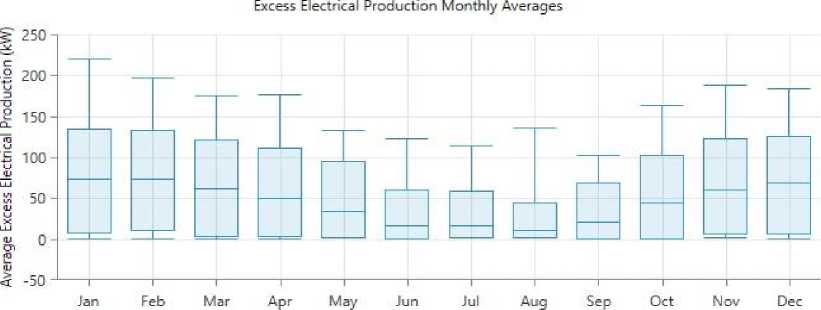
Month
Fig. 24. Excess electrical production monthly average of proposed hybrid system of PV, wind, hydro, diesel generator, electrolyzer, reformer and battery.
Table 5. Emission rates of different gases.
|
Quantity |
Value (kg/year) |
|
Carbon Dioxide |
3,246 |
|
Carbon Monoxide |
20.5 |
|
Unburned Hydrocarbons |
0.893 |
|
Particulate Matter |
0.124 |
|
Sulfur Dioxide |
7.95 |
|
Nitrogen Oxides |
19.2 |
-
3.10 Sensitivity analysis
4. Conclusions
Diesel price is considered a sensitivity parameter. Different values of diesel price, i.e., $0.92/L, $1.00/L, and $1.2/L, affect the cost of energy (COE). For $0.92/L, $1.00/L, and $1.2/L diesel price, the COE will be increased to $0.271, $0.273, and $0.278, respectively. Based on diesel prices, the hybrid system is analyzed. Different values of diesel prices do not affect the production of electricity.
The current study examines the hybridized system's electrification potential of the study area by simulating with minimum COE and controlling the emission of harmful gasses. Among the various hybrid system options, PV-wind-hydro-diesel generator-electrolyzer-reformer based hybrid system with battery is the most optimal feasible solution. The results of Homer software processing also showed that the study area has a lot of potential for renewable energy, especially hydropower energy. But the renewable energies are not always available. So, the diesel generator with renewable energy sources will be the best techno-economic feasible solution. The simulation result of Homer software shows that the COE of the optimized system is $0.281. The simulation also indicates that the proposed hybrid system reduces carbon emissions. Thus, this research suggests that constructing a hybrid PV-wind-hydro power plant in the Delduar, Tangail, Bangladesh area is both technically and economically feasible.
Acknowledgement
This research is supported by Begum Rokeya University, Rangpur, Bangladesh.
Список литературы The Techno-Economic Feasibility Serves to Optimize the PV-Wind-Hydro Hybrid Power System at Tangail in Bangladesh
- L. B. Braga, J. L. Silveira, M. E. Da Silva, C. E. Tuna, E. B. Machin, and D. T. Pedroso, “Hydrogen production by biogas steam reforming: A technical, economic and ecological analysis,” Renewable and Sustainable Energy Reviews, vol. 28, pp. 166–173, 2013, doi: 10.1016/j.rser.2013.07.060.
- M. A. Habib, K. M. A. Kabir, and J. Tanimoto, “Evolutionary Game Analysis for Sustainable Environment Under Two Power Generation Systems,” Evergreen Joint Journal of Novel Carbon Resource Sciences & Green Asia Strategy, Vol. 09, Issue 02, pp. 323-341, June, 2022.
- V. Garcia-Heller, R. Espinasa, and S. Paredes, “Forecast study of the supply curve of solar and wind technologies in Argentina, Brazil, Chile and Mexico,” Renew Energy, vol. 93, pp. 168–179, 2016, doi: 10.1016/j.renene.2016.02.065.
- A. A. Solomon, D. M. Kammen, and D. Callaway, “Investigating the impact of wind-solar complementarities on energy storage requirement and the corresponding supply reliability criteria,” Appl Energy, vol. 168, pp. 130–145, 2016, doi: 10.1016/j.apenergy.2016.01.070.
- P. G. Mura, R. Baccoli, R. Innamorati, and S. Mariotti, “An energy autonomous house equipped with a solar PV hydrogen conversion system,” Energy Procedia, vol. 78, pp. 1998–2003, 2015, doi: 10.1016/j.egypro.2015.11.392.
- S. M. M. Ehteshami, S. Vignesh, R. K. A. Rasheed, and S. H. Chan, “Numerical investigations on ethanol electrolysis for production of pure hydrogen from renewable sources,” Appl Energy, vol. 170, pp. 388–393, 2016, doi: 10.1016/j.apenergy.2016.03.001.
- M. M. U. Rashid, M. A. Habib, and M. M. Hasan, “Design and construction of the solar photovoltaic simulation system with the implementation of MPPT and boost converter using MATLAB/Simulink,” Asian Journal of Current Research, vol. 3, pp. 27–36, 2019.
- Md. Samiul Islam, Faridul Islam, Md. Ahsan Habib, "Feasibility Analysis and Simulation of the Solar Photovoltaic Rooftop System Using PVsyst Software", International Journal of Education and Management Engineering(IJEME), Vol.12, No.6, pp.21-32, 2022. doi:10.5815/ijeme.2022.06.03
- S. Sinha and S. S. Chandel, “Review of recent trends in optimization techniques for solar photovoltaic-wind based hybrid energy systems,” Renewable and Sustainable Energy Reviews, vol. 50, pp. 755–769, 2015, doi: 10.1016/j.rser.2015.05.040.
- M. A. Habib, “Wind Speed Data and Statistical Analysis for Rangpur District in Bangladesh,” Journal of Electrical Engineering, Electronics, Control and Computer Science –JEEECCS, Volume 8, Issue 30, pp. 1-10, 2022.
- T. Maatallah, N. Ghodhbane, and S. Ben Nasrallah, “Assessment viability for hybrid energy system (PV/wind/diesel) with storage in the northernmost city in Africa, Bizerte, Tunisia,” Renewable and Sustainable Energy Reviews, vol. 59, pp. 1639–1652, 2016, doi: 10.1016/j.rser.2016.01.076.
- Md. S. Islam, N. A. Noman, and Md. A. Habib, “The Best Techno-economic Aspects of the Feasibility Study Concerning the Proposed PV-Wind-hydro Hybrid System in Nilphamari, Bangladesh,” International Journal of Education and Management Engineering, vol. 12, no. 5, pp. 24–37, Oct. 2022, doi: 10.5815/ijeme.2022.05.04.
- Z. Abdin, C. J. Webb, and E. M. A. Gray, “Solar hydrogen hybrid energy systems for off-grid electricity supply: A critical review,” Renewable and Sustainable Energy Reviews, vol. 52. Elsevier Ltd, pp. 1791–1808, Dec. 01, 2015. doi: 10.1016/j.rser.2015.08.011.
- M. N. Uddin and W. M. A. W. Daud, “Technological diversity and economics: Coupling effects on hydrogen production from biomass,” Energy and Fuels, vol. 28, no. 7, pp. 4300–4320, 2014, doi: 10.1021/ef5007808.
- M. A. Habib, “Game Theory, Electrical Power Market and Dilemmas,” Journal of Electrical Engineering, Electronics, Control and Computer Science –JEEECCS, vol. 8, pp. 33–42, 2022.
- M. A. Habib, “The application of asymmetric game in the electrical power market,” Journal of Electrical Engineering, Electronics, Control and Computer Science –JEEECCS, 2022.
- M. A. Habib, “‘Can People Detect Dilemma Strength in A 2 Player 2 Strategy Game?’: A Survey Game,” Proceeding of International Exchange and Innovation Conference on Engineering & Sciences (IEICES), vol. 5, pp. 116–117, 2019.
- M. A. Habib, K. M. A. Ariful Kabir, and J. Tanimoto, “‘Do humans play according to the game theory when facing the social dilemma situation?’ A survey study,” Evergreen, vol. 7, no. 1, pp. 7–14, 2020, doi: 10.5109/2740936.
- M. A. Habib, M. Tanaka, and J. Tanimoto, “How does conformity promote the enhancement of cooperation in the network reciprocity in spatial prisoner’s dilemma games?,” Chaos Solitons Fractals, vol. 138, p. 109997, 2020, doi: 10.1016/j.chaos.2020.109997.
- K. Y. Lau, M. F. M. Yousof, S. N. M. Arshad, M. Anwari, and A. H. M. Yatim, “Performance analysis of hybrid photovoltaic/diesel energy system under Malaysian conditions,” Energy, vol. 35, no. 8, pp. 3245–3255, 2010, doi: 10.1016/j.energy.2010.04.008.
- R. M. Shrestha, G. Anandarajah, and M. H. Liyanage, “Factors affecting CO2 emission from the power sector of selected countries in Asia and the Pacific,” Energy Policy, vol. 37, no. 6, pp. 2375–2384, 2009, doi: 10.1016/j.enpol.2009.01.032.
- M. D. A. Al-falahi, S. D. G. Jayasinghe, and H. Enshaei, “A review on recent size optimization methodologies for standalone solar and wind hybrid renewable energy system,” Energy Convers Manag, vol. 143, pp. 252–274, 2017, doi: 10.1016/j.enconman.2017.04.019.
- B. Laoun, A. Khellaf, M. W. Naceur, and A. M. Kannan, “Modeling of solar photovoltaic-polymer electrolyte membrane electrolyzer direct coupling for hydrogen generation,” Int J Hydrogen Energy, vol. 41, no. 24, pp. 10120–10135, 2016, doi: 10.1016/j.ijhydene.2016.05.041.
- F. Yilmaz, M. T. Balta, and R. Selbaş, “A review of solar based hydrogen production methods,” Renewable and Sustainable Energy Reviews, vol. 56, pp. 171–178, 2016, doi: 10.1016/j.rser.2015.11.060.
- M. Qolipour, A. Mostafaeipour, and O. M. Tousi, “Techno-economic feasibility of a photovoltaic-wind power plant construction for electric and hydrogen production: A case study,” Renewable and Sustainable Energy Reviews, vol. 78, no. April, pp. 113–123, 2017, doi: 10.1016/j.rser.2017.04.088.
- A. U. Chávez-Ramírez, J. C. Cruz, R. Espinosa-Lumbreras, J. Ledesma-García, S. M. Durón-Torres, and L. G. Arriaga, “Design and set up of a hybrid power system (PV-WT-URFC) for a stand-alone application in Mexico,” Int J Hydrogen Energy, vol. 38, no. 28, pp. 12623–12633, 2013, doi: 10.1016/j.ijhydene.2012.11.019.
- A. S. Joshi, I. Dincer, and B. V. Reddy, “Solar hydrogen production: A comparative performance assessment,” Int J Hydrogen Energy, vol. 36, no. 17, pp. 11246–11257, 2011, doi: 10.1016/j.ijhydene.2010.11.122.
- Z. Yang, G. Zhang, and B. Lin, “Performance evaluation and optimum analysis of a photovoltaic-driven electrolyzer system for hydrogen production,” Int J Hydrogen Energy, vol. 40, no. 8, pp. 3170–3179, 2015, doi: 10.1016/j.ijhydene.2015.01.028.
- M. M. U. Rashid, M. M. Rahman, M. A. Habib, and M. M. Hasan, “Study and analysis of hybrid energy options for electricity study and analysis of hybrid energy options for electricity production in Rangpur, Bangladesh,” Asian Journal of Current Research, vol. 3, pp. 9–14, 2019.
- “Bangladesh Map - Wikipedia.” https://en.wikipedia.org/wiki/Portal:Bangladesh/Map (accessed Jul. 04, 2022).
- “Wind Resource.” https://www.homerenergy.com/products/pro/docs/latest/wind_resource.html (accessed Jun. 14, 2022).
- “Solar GHI Resource.” https://www.homerenergy.com/products/pro/docs/latest/solar_ghi_resource.html (accessed Jun. 14, 2022).
- “Hydrogen Load.” https://www.homerenergy.com/products/pro/docs/latest/hydrogen_load.html (accessed Jun. 15, 2022).
- “Electric Load.” https://www.homerenergy.com/products/grid/docs/latest/electric_load.html (accessed Jun. 15, 2022).
- “Bangladesh Water Development Board.” http://bwdb.tangail.gov.bd/ (accessed Jun. 11, 2022).
- “Surrette Rolls 4KS 25P.” https://voltaico.com/product/surrette-rolls-4-ks-25p-1404ah-4v-deep-cycle-battery/ (accessed Jul. 04, 2022).
- “Converter.” https://www.homerenergy.com/products/pro/docs/latest/converter.html (accessed Jul. 04, 2022).

